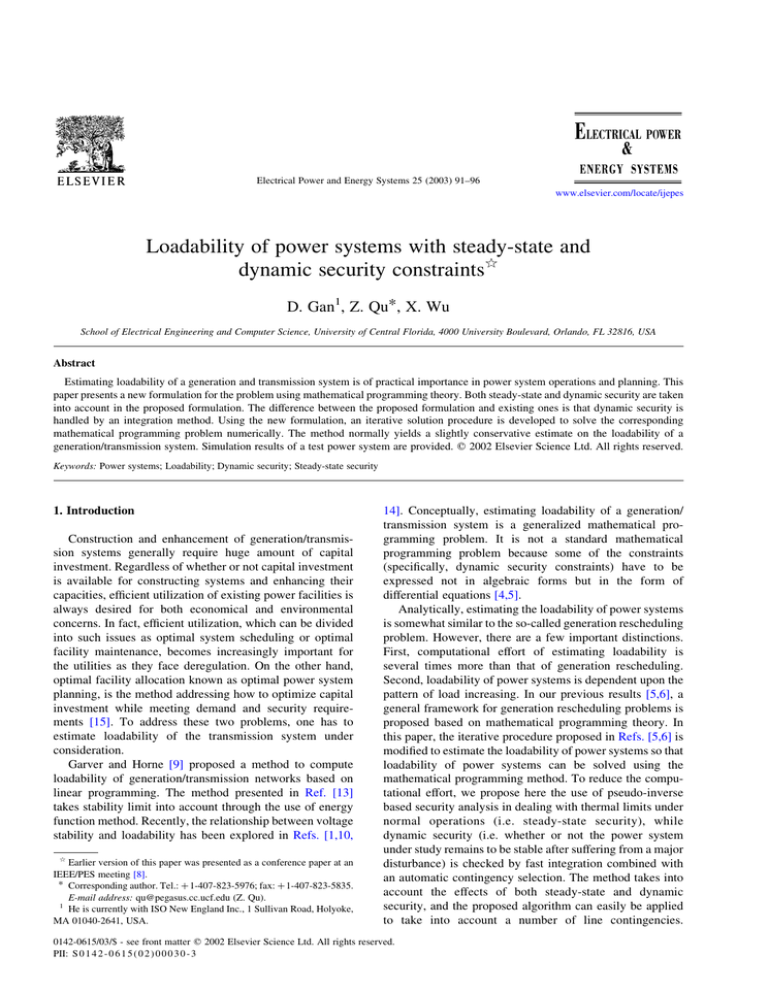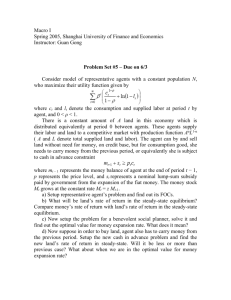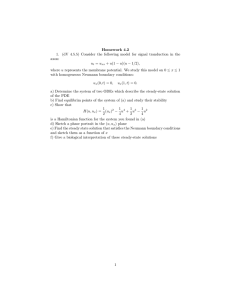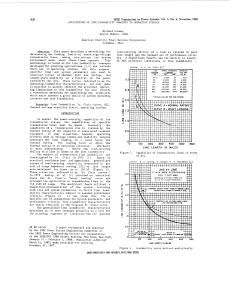
Electrical Power and Energy Systems 25 (2003) 91–96
www.elsevier.com/locate/ijepes
Loadability of power systems with steady-state and
dynamic security constraintsq
D. Gan1, Z. Qu*, X. Wu
School of Electrical Engineering and Computer Science, University of Central Florida, 4000 University Boulevard, Orlando, FL 32816, USA
Abstract
Estimating loadability of a generation and transmission system is of practical importance in power system operations and planning. This
paper presents a new formulation for the problem using mathematical programming theory. Both steady-state and dynamic security are taken
into account in the proposed formulation. The difference between the proposed formulation and existing ones is that dynamic security is
handled by an integration method. Using the new formulation, an iterative solution procedure is developed to solve the corresponding
mathematical programming problem numerically. The method normally yields a slightly conservative estimate on the loadability of a
generation/transmission system. Simulation results of a test power system are provided. q 2002 Elsevier Science Ltd. All rights reserved.
Keywords: Power systems; Loadability; Dynamic security; Steady-state security
1. Introduction
Construction and enhancement of generation/transmission systems generally require huge amount of capital
investment. Regardless of whether or not capital investment
is available for constructing systems and enhancing their
capacities, efficient utilization of existing power facilities is
always desired for both economical and environmental
concerns. In fact, efficient utilization, which can be divided
into such issues as optimal system scheduling or optimal
facility maintenance, becomes increasingly important for
the utilities as they face deregulation. On the other hand,
optimal facility allocation known as optimal power system
planning, is the method addressing how to optimize capital
investment while meeting demand and security requirements [15]. To address these two problems, one has to
estimate loadability of the transmission system under
consideration.
Garver and Horne [9] proposed a method to compute
loadability of generation/transmission networks based on
linear programming. The method presented in Ref. [13]
takes stability limit into account through the use of energy
function method. Recently, the relationship between voltage
stability and loadability has been explored in Refs. [1,10,
q
Earlier version of this paper was presented as a conference paper at an
IEEE/PES meeting [8].
* Corresponding author. Tel.: þ 1-407-823-5976; fax: þ1-407-823-5835.
E-mail address: qu@pegasus.cc.ucf.edu (Z. Qu).
1
He is currently with ISO New England Inc., 1 Sullivan Road, Holyoke,
MA 01040-2641, USA.
14]. Conceptually, estimating loadability of a generation/
transmission system is a generalized mathematical programming problem. It is not a standard mathematical
programming problem because some of the constraints
(specifically, dynamic security constraints) have to be
expressed not in algebraic forms but in the form of
differential equations [4,5].
Analytically, estimating the loadability of power systems
is somewhat similar to the so-called generation rescheduling
problem. However, there are a few important distinctions.
First, computational effort of estimating loadability is
several times more than that of generation rescheduling.
Second, loadability of power systems is dependent upon the
pattern of load increasing. In our previous results [5,6], a
general framework for generation rescheduling problems is
proposed based on mathematical programming theory. In
this paper, the iterative procedure proposed in Refs. [5,6] is
modified to estimate the loadability of power systems so that
loadability of power systems can be solved using the
mathematical programming method. To reduce the computational effort, we propose here the use of pseudo-inverse
based security analysis in dealing with thermal limits under
normal operations (i.e. steady-state security), while
dynamic security (i.e. whether or not the power system
under study remains to be stable after suffering from a major
disturbance) is checked by fast integration combined with
an automatic contingency selection. The method takes into
account the effects of both steady-state and dynamic
security, and the proposed algorithm can easily be applied
to take into account a number of line contingencies.
0142-0615/03/$ - see front matter q 2002 Elsevier Science Ltd. All rights reserved.
PII: S 0 1 4 2 - 0 6 1 5 ( 0 2 ) 0 0 0 3 0 - 3
92
D. Gan et al. / Electrical Power and Energy Systems 25 (2003) 91–96
Nomenclature
Pmi ; Qmi real and reactive power generation by the ith generator
Q0mi ; P0Li and Q0Li initial values of reactive power generation, active power load, and reactive power load at the ith bus,
respectively
di ðtÞ; vi ; Mi ; Pgi rotor angle, angular velocity, inertial constant, transient electrical power output of the ith machine,
respectively
Ts
time span of transient response considered
ui ðtÞ; Vi ; u, V angle at the ith bus, voltage magnitude at the ith bus, and column vectors formed by elements ui and Vi ;
respectively
Gij ; Bij conductance and susceptance of the transmission line between the ith and jth buses
Ei
voltage of the ith machine behind its transient reactance
gij ; bij conductance and susceptance of the reduced admittance matrix corresponding to the ith and jth machines
d
the maximum limit on relative swing angle allowed between any pair of machines (for instance, 1808)
Pi ðV; uÞ; Qi ðV; uÞ active and reactive power injections at the ith bus, respectively
Pmi ; Qmi lower limits of Pmi and Qmi ; respectively
mi upper limits of Pmi and Qmi ; respectively
P mi ; Q
Ti ; Ti active power through the ith transmission line, and its thermal limit
NB, NL, Ng, Nc total number of buses, total number of transmission lines, total number of generators, and total number of
contingencies under consideration, respectively
dli ðtÞ
rotor angle of the ith machine at time t under the lth contingency
Simulation results of a 6-machine 22-node test power
system are reported.
Qi ðV; uÞ þ Wi a; Si Q0m 2 aQ0Li ¼ 0;
ð3Þ
Pmi # Pmi # P mi ;
2. Mathematical formulation
In this section, the problem of estimating loadability of
transmission systems is formulated using the terminology of
mathematical programming theory. We begin with two
remarks pertaining to the new formulation. The first one is
about an assumption on changes of active and reactive
power. It is assumed that the changes of active and reactive
power at each power station are proportional to each other in
the proposed formulation. While this assumption is not
necessarily required (as one may simply impose any other
rule on changes of power generation), such an assumption is
made for the ease of presentation. The second one is about
numerical algorithm. Although the proposed formulation is
given in the form of mathematical programming, typical
algorithms such as simplex algorithm and steepest descent
algorithm, etc. cannot be used to solve the problem. This is
because the formulation, as will be discussed later, is much
more complicated than conventional mathematical programming models. Consequently, heuristics-based algorithms will have to be developed to solve the formulation.
Now we are in a position to present the formulation.
Objective:
i ¼ 1; 2; …; NB ;
mi ;
Qmi # Qmi # Q
2T i # Ti # T i ;
i ¼ 1; 2; …; Ng ;
i ¼ 1; 2; …; Ng ;
i ¼ 1; 2; …; NL ;
and
l
di ðtÞ 2 dlj ðtÞ # d;
ð4Þ
ð5Þ
ð6Þ
ð7Þ
t ¼ ½0; Ts ; i; j ¼ 1; 2; …; Ng ; l ¼ 1; 2; …; Nc ;
where
Si ðPg Þ
(
¼
0
if no machine is attached to bus i
Pgj
if the jth machine is attached to bus i for some j [ {0; …; Ng }
;
function Si ðQ0m Þ is defined in the same way, Wi(·) is a userdefined function to specify the change of reactive power
generation:
Pi ðV; uÞ ¼
NB
X
Vi Vj ½Gij cosðui 2 uj Þ þ Bij sinðui 2 uj Þ;
ð8Þ
j¼1
ð1Þ
Max a
Qi ðV; uÞ ¼
subject to the following constraints:
NB
X
Vi Vj ½Gij sinðui 2 uj Þ 2 Bij cosðui 2 uj Þ: ð9Þ
j¼1
Pi ðV; uÞ þ Si ðPg Þ 2 aP0Li ¼ 0;
i ¼ 1; 2; …; NB ;
ð2Þ
di is the solution to the following second-order ordinary
D. Gan et al. / Electrical Power and Energy Systems 25 (2003) 91–96
differential equation:
ddi
dv
¼ vi ; Mi i ¼ Pmi 2 Pgi ;
dt
dt
i ¼ 1; 2; …; Ng ; ð10Þ
93
sence of constraints (7) and (10). To solve this programming
problem, one has to rely on engineering judgment. In
Section 3, an algorithm based on such an approach is
provided.
and
Pgi ¼
NG
X
Ei Ej ½gij cosðdi 2 dj Þ þ bij sinðdi 2 dj Þ:
ð11Þ
j¼1
All symbols in Eqs. (2) – (11) are defined in the nomenclature. More detailed explanations of the above expressions
and their parameters can be found in Refs. [11,12,16].
In the problem statement (1), a is the percentage of the
overall system real load versus its initial load value.
Quantity a is referred to as loadability factor, and it is
also the objective function of the programming problem. In
the formulation, a and Pmi are adjustable variables. During
the transient period, electrical power Pgi changes, while
mechanical power Pmi does not. The objective of mathematical programming is to find the largest a and the
corresponding mechanical power Pmi ; i ¼ 1; 2; …; Ng ; such
that various steady-state and dynamic constraints are
satisfied.
In this paper, both steady-state and dynamic security
issues are considered. Inequalities (2) –(6) are thermal limits
and form the so-called steady-state security constraints.
Additional steady-state constraints such as line contingencies can be added, and inequality (7) together with Eq. (10)
is a dynamic security constraint. Constraints (2) – (4), (6)
and (7) are imposed in our study, but constraint (5) is not
enforced as reactive power is little related to transient
stability. Should single-axis and/or two-axis machine
models be used, swing equations (10) and (11) can be
changed accordingly. Thus, the proposed formulation is
generic in the sense that various extensions can be made.
For multi-machine power systems, there has been no
result on how to conclude analytically their exact stability
regions. Instead, whether an initial condition is in the
stability region can be determined by integrating the system
trajectory. Without knowing the stability boundary, one can
resort him/herself to a relative stability measure (which may
lead to a somewhat conservative result), and inequality (7) is
one of such choices. In the proposed formulation, d is a usersupplied parameter and, when its value is set to be smaller, a
more conservative solution will be generated. In the
simulation to be presented, d is set to be 1808.
It should be noted that in the proposed formulation,
dynamic security is explicitly considered through a robust
procedure. Specifically, dynamic security is checked by the
Runge – Kutta method which is most reliable at present. We
also employ the so-called sensitivity factor (or PTDF)
method to calculate line flows. The exact equation, which is
based on linearized AC load flow, is to be stated in the
following sections. In addition, the programming problem
given by Eqs. (1) –(10) is not solvable using any existing
mathematical programming package because of the pre-
3. The proposed solution procedure
An overview of the proposed solution procedure is given
first, followed by its detailed descriptions.
3.1. Overview of the procedure
It is obvious that the mathematical programming
formulation, given by Eqs. (1) – (7), has three major
components: the loadability factor and Pmi ; steady-state
security constraints given by Eqs. (2) –(6), and dynamic
security constraints given by Eq. (7). The proposed
procedure explores the relationship among these three
components.
The objective of maximizing loadability factor a and its
corresponding active power generation distribution can be
met by using an iterative algorithm. The proposed iteration
scheme, shown by Fig. 1, consists of two layers.
Numerically, it is a two-kernel procedure. The first is
security assessment procedure, and the second is generation
adjustment procedure. The first layer is the outer-loop
iteration within which loadability factor a is increased each
Fig. 1. Flowchart of the solution procedure.
94
D. Gan et al. / Electrical Power and Energy Systems 25 (2003) 91–96
time by a small increment. This layer of iteration is always
repeated unless the first kernel fails a number of times
consecutively. The second layer is the inner-loop iteration
within which distribution of active power generation is
adjusted through the second kernel to meet the steady-state
and dynamic security constraints specified by the first
kernel. Overall, iteration is continued until no meaningful
improvement on loadability factor can be achieved. By
nature, computational effort of the problem is several times
more than that of a generation rescheduling problem (for
which outer-loop iteration is not needed).
It is apparent that efficiency of the inner-loop iteration
depends on the algorithm chosen for generation adjustment
and that performance of the security assessment routine has
major impacts on the overall computation time. Procedures
used for security assessment and generation adjustment will
be discussed in Sections 3.2 and 3.3, respectively.
3.2. Security assessment
In general, steady-state security assessment should
include ðn 2 1Þ contingency analysis. In this paper,
evaluation of steady-state security is simplified to be a
standard load flow analysis, which is familiar to power
audience. Contingency analysis, if desired, can easily be
incorporated into the proposed framework.
The algorithm used for dynamic security assessment is a
step-by-step integration procedure. It fully exploits sparse
matrix/vector techniques and contains an automatic contingency selection approach developed previously by the
authors. Details about the algorithm can be found in Ref. [7].
equation:
T 0l ¼ Tl þ
Ng
X
Hli ðP0mi 2 Pmi Þ;
ð12Þ
i¼1
where Tl and T 0l are the line flows of the lth transmission line
before and after re-dispatching active power generation,
respectively. Weighting Hli is the so-called sensitivity factor
[16], and it relates active power injection to the line flow.
Step 4. Check inequality (6) to see if thermal limit of
transmission lines has been violated. If lT 0l l , T l for all
l ¼ 1; 2; …; NL ; stop adjusting generation and go to step
‘Re-compute load flow’ defined at the bottom of Fig. 1.
Otherwise, proceed with Step 5.
Step 5. Rewrite the linearized load flow equation (12) as
DT ¼ HðP00m 2 P0m Þ;
ð13Þ
where vector DT consists of all the changes of transmission
line active power flow as its components, elements of matrix
H are Hli ; l ¼ 1; 2; …; NL ; i ¼ 1; 2; …; Ng ; vector P0m is of
dimension Ng and its elements are P0mi ; and P00m denotes the
new active power generation vector to be decided.
Form vector DT of appropriate dimension by defining its
elements as DTk ¼ T 0k 2 Tk ; where k [ c; and c is the set
containing the number of transmission lines at which
violations of thermal limit on line flow are observed in
Steps 3 and 4. Note that DT is a ‘condensed’ vector, and its
dimension is denoted by NT : In other words, the transmission lines without any line flow violation are excluded
from DT.
Step 6. Construct NT £ Ng matrix S whose elements on
the lth row are Hli ; i ¼ 1; 2; …; Ng : It follows from Eq. (13)
that
3.3. Adjustment of generation
P00m ¼ P0m þ ST ðS·ST Þ21 ·DT;
The algorithm used to adjust generation is a numerical
implementation of the following steps:
Step 1. Classify and group the available generators in the
system into three sets: those machines that are severely
disturbed, machines that are slightly disturbed, and
generators connected to a swing bus. Criteria for classification should be based on machine acceleration at the
instant when a fault occurs and on machine kinetic energy at
the instant that the fault is cleared.
Step 2. Re-dispatch active power generation of the
machines according to the following guidelines. For
severely disturbed generators, reduce their active power
generations by a small percentage (say 5%). For slightly
disturbed machines, do not change their generations. For
swing machines, increase their active power generation to
compensate for the total reduction of generation at disturbed
generators. Let the active power generations of the ith
machine before and after the adjustment be denoted by Pmi
and P0mi ði ¼ 1; 2; …; Ng Þ; respectively.
Step 3. Evaluate line flow using the linearized line flow
where superscript T denotes transpose. Eq. (14) is the socalled pseudo-inverse based steady-state security control
formulation in Refs. [2,3].
Step 7. Set Pm ¼ P00m and go to the step Re-compute load
flow defined at the bottom of Fig. 1.
The procedure of generation adjustment involves verification of both dynamic security and steady-state security.
Specifically, the steady-state security control algorithm
given in Refs. [2,3] is extended so that, while steady-state
security is studied in Steps 3– 7 based on the extended
version of pseudo-inverse method, dynamic security is
verified in Steps 1 and 2 (based on heuristics). This
extension makes it possible to handle steady-state and
dynamic security in a unified way in the dispatch algorithm.
Incremental generation adjustments chosen separately to
alleviate either steady-state insecurity or dynamic insecurity
may sometime conflict with each other. For example, the
mechanical power of a group of generators need to be
reduced to eliminate dynamic insecurity; but such a
reduction could cause steady-state insecurity or make it
worse. When this type of cases arises, our solution is: first
ð14Þ
D. Gan et al. / Electrical Power and Energy Systems 25 (2003) 91–96
95
Table 2
Power injection mode of test power system when a is increased to 1.03
Fig. 2. Single-line diagram of test power system.
adjust mechanical power of some of the machines to ensure
dynamic security and then adjust other generators to
alleviate steady-state insecurity. Since the number of
binding constraints is relatively small in real-world power
systems, this heuristics procedure should work reasonably
well, especially if the user performs his/her calculations in
an interactive way.
4. Simulation results
The proposed formulation has been applied to the 6machine, 22-node test power system defined by Fig. 2.
Original data of this test system is available upon request.
Note that machine 6 is not a generating unit but a var
resource. Consequently, it is not considered in the process of
generation adjustment.
In the simulation, the specified limit on iteration counter
K in Fig. 1 is set to be 4. The initial active power generation
Table 1
Initial power injection mode of test power system
Location
Active power generation
1
2
3
4
5
6
8
9
16
18
19
20
21
22
5.7000
5.4990
3.0000
1.6000
4.3000
20.0100
Active power load
Location
Active power generation
1
2
3
4
5
6
8
9
16
18
19
20
21
22
6.1454
6.1766
3.1929
1.6475
4.4271
20.0100
Active power load
2.9553
3.8709
5.1483
4.4275
0.8856
0.7406
0.7209
2.3316
and demand are listed in Table 1. Note that the test system is
secure both in the steady-state and dynamically under this
initial pattern of power injection. For briefness, detailed
results of security assessment are not included here.
To test the proposed numerical procedure, loadability
factor is increased in increments of 1%. Our simulation
shows that the test system remains to be secure at values of
a ¼ 1:0; 1.01, and 1.02. However, when loadability equals
1.03, the test system is only dynamically secure but not
steady-state secure. Three thermal limit violations are
found: active power flow across lines 2 – 9 is 6.1766 which
is over the limit 6.00; active power flow across lines 3– 22 is
3.1929 (over the limit 3.00); and active power flow across
lines 5 –28 is 4.4271 (over the limit 4.00). Generation
injections in this case are listed in Table 2.
Now the generation adjustment algorithm described in
Section 3.3 is applied. After three inner iterations, the test
system is made to be both steady-state and dynamically
secure. The active power generations after adjustment are
listed in Table 3, and some of the dynamic security
assessment results are listed in Table 4.
Our simulation also shows that if a is increased to 1.04,
secure active power generation configuration cannot be
found even after generation adjustment. Therefore, the
numerical simulation suggests that the maximum loadability factor of the test system is between 1.03 and
1.04. Further study is needed to see if this result is
conservative.
Table 3
Active power generation after adjustment when a equals to 1.03
2.8700
3.7600
5.0000
0.7190
2.2650
0.7000
0.8600
4.300
Location
Active power generation
1
2
3
4
5
6
7.0600
5.5000
3.0000
2.0000
4.0000
20.0100
96
D. Gan et al. / Electrical Power and Energy Systems 25 (2003) 91–96
Table 4
Dynamic security assessment results of test system when a equals to 1.03
Contingency location
Maximum relative swing angle (8)
8
9
11
12
13
18
64.2
64.6
163.8
172.0
72.0
60.8
22
22
12
11
12
16
5. Conclusions
The problem of calculating loadability of generation/
transmission systems has gained renewed interests in recent
years partly because deregulation of utility industry are
being undertaken in many countries. Finding an exact
solution to the problem is formidable due to the limitations
of existing mathematical methodologies. In this paper, a
new algorithm is proposed to estimate the maximum
loadability factor of a power system, and it is evolved
from those algorithms developed previously by the authors
for generation rescheduling. A successful application
would involve judicious engineering judgment. The
unique features of the method are that both steadystate and dynamic security are taken into account and
that dynamic security is analyzed using an integration
algorithm (which makes the proposed method more
robust). In addition to the fact that simplification is
employed in computing load flow equations and
dynamic security constraints, our simulation results suggest
that the proposed algorithm is quite promising. Research is
under way to loose the assumptions currently employed in
the algorithm.
Acknowledgments
The authors would like to acknowledge the past support
of Kentex Corporation, Redwood City, CA.
References
[1] Chiang HD, Jean-Jumeau R. A more efficient formulation for
computation of the maximum loading points in electric power
systems. IEEE Trans Power Syst 1995;10(2):635 –46.
[2] Ekwue AO, Short MJ. Interactive security evaluation in power system
operation. Proc IEE, Part C 1983;130(2):61–70.
[3] Ekwue AO. Extended security enhancement algorithm for power
systems. Electr Power Syst Res 1991;20.
[4] Gan D, Thomas R, Zimmerman R. Stability-constrained optimal
power flow. IEEE Trans Power Syst 2000;15(2):535–40.
[5] Gan D, Qu Z, Cai H, Wang X. A methodology and computer package
for generation rescheduling. IEE Proc, Part C 1997;144(3):301–7.
[6] Gan D, Qu Z. Integrated preventive control for steady-state and
dynamic security by sensitivity factors. Proceedings of IFAC
Symposium of Control on Power Plant and Power Systems, Cancun,
Mexico, December 3–5, 1995.
[7] Gan D, Qu Z, Yan Z. Dynamic security assessment and automatic
contingency selection: some experimental results. Int J Power Energy
Syst 1998;18(2):110 –5.
[8] Gan D, Qu Z, Cai H, Wang X. Loadability of generation/transmission
systems with unified steady-state and dynamic security constraints.
14th IEEE/PES Transmission and Distribution Conference and
Exposition, Los Angles, CA, September, 1996.
[9] Garver LL, Horne GE. Load supplying capability of generation–
transmission networks. IEEE Trans Power Appar Syst 1979;98(3):
957 –62.
[10] Irisarri GD, Wang X, Tong J, Mokhtari S. Maximum loadability of
power systems using interior point nonlinear optimization method.
IEEE Trans Power Syst 1997;12(1):162–72.
[11] Kundur P. Power system stability and control. New York: McGrawHill; 1994.
[12] Sauer PW, Pai MA. Power system dynamics and stability. Englewood
Cliffs, NJ: Prentice Hall; 1998.
[13] Sauer PW, Demaree KD, Pai MA. Stability limited load supply and
interchange capacity. IEEE Trans Power Appar Syst 1983;102(11):
3637–43.
[14] Sauer PW, Leisieutre BC, Pai MA. Maximum loadability and voltage
stability in power systems. Int J Electr Power Energy Syst 1993;15(3):
145 –54.
[15] Wang X, McDonald JR. Modern power system planning. New York:
McGraw-Hill; 1994.
[16] Wood AJ, Wollenberg BF. Power generation, operation and control.
New York: Wiley; 1984.







